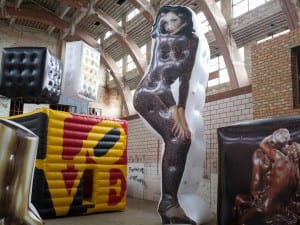Michael Boroniec is an American artist, based in Massachusetts who studied at Rhode Island School of Design. The peculiarity of his art resides in the use of ceramic as a primary material. Boroniec’s Spatial Spirals series involves to create sculptural objects by modelling vessel thrown on the wheel, into open spirals. His body of work aims to confer elegance and motion to a material which is normally perceived and hard and heavy. We speak to the artist about his processes and the mutual effects of art on the individual.
A: What made you first think of using ceramic material to produce works of fine art?
MB: As a child I always loved to paint and draw. I would de-assemble my toys to see how they worked and rebuild something entirely new. When I was 8 my mother would take me to ceramic classes. It was here I first felt clay could take on an infinite amount of forms and expressions. Not only is clay one of the most abundant and oldest materials on earth, making up 75 percent of Earth’s crust, but it is deeply rooted in civilizations. To me it became a material of expression in a long lineage of history.
A: The material you use undeniably holds a tactile nature that perhaps other art media lacks, is there something specific that you find within this that resonates with you?
MB: There is something humbling about feeling the earth between my hands. Even when I paint I don’t like to use a brush. It is the physical connection between material and consciousness, working innately with a medium so malleable that transmutes into “stone” and becomes permanent.
A: Do you think that a physical craft is linked to a psychological state of mind?
MB: Yes, it makes the artwork more impulsive, more in the moment. There are signs of human touch and for that reason it is a more intimate artwork than industrial made works that we see so much of today. The physical connection between the earth and consciousness lends itself to an introspective state.
A: What, if any, is the message behind your work?
MB: My work takes what many consider a craft and bridge the gap to what people consider Fine Art. When I look at Art I find myself I am drawn to works with a lot of skill, patience, and dedication to a material as well as a strong conceptual aspect. I try to bring that same dichotomy to my work.
A: What are the most recurrent themes in your work?
MB: There are two main avenues to my ceramic works. One focuses on the concept between functional art and sculptural objects. The other interprets current events and personal experiences into sculptural works.
A: Could you talk about the dialogue between functional art and the sculptural object; how closely are these two things aligned and how does this inform your intention for the pieces?
MB: Functional Art are works intended for use, often beautifully crafted. Sculptural Objects are forms meant for interpretation and often can be based off a functional item.
A: Has your personal life influenced your art in anyway?
MB: Not only is my personal life reflected in my work, but Art has enhanced my life. The studio is a place of reflection.
A: About the Spatial Spirals you say that “it all began with teapots and a single spiral.” Could you offer a bit more detail towards this explanation? Is there a narrative behind your practice?
MB: One day I was making a teapot and I had a stroke of inspiration to slice it open. The results were excellent so I took all my knowledge of ceramics and glazes and began pushing the limits of the material into the ‘Spatial Spiral series’ you see today.
A: You mention literature as a medium tied to your work; how far do you think that all
art forms are inherently linked both in influence and execution?
MB: Art and literature are linked by a common purpose. They both seek to convey a story with the ultimate goal of expressing and defining the human condition. While not all of my sculptural works convey a literal story, they do express feeling, motion, and emotion that allow the viewer to interpret their own story.
Credits:
1.Spatial Spiral; Crackle II Earthenware, Glaze, Ashfield Schist. Courtesy of the artist.
2.Spatial Spiral; Crawl V Earthenware, Glaze, Found Subway Tile. Courtesy of the artist.



